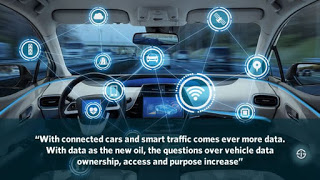credit: I Scoop
Gone are the days when insurance companies used race, sex and a person’s age to determine their auto insurance premiums.
A new whitepaper by Cognizant, titled “The New Auto Insurance Ecosystem: Telematics, Mobility and the Connected Car” reveals the real reasons why auto manufacturers are installing machine-to-machine (M2M) communication, or telematics in new cars.
“Nowhere is this more clear than in auto/motor insurance, where advances in M2M communication, or telematics, are rippling across the marketplace, generating data to more precisely assess risk and reward for policyholders who adhere to safe driving practices.”
The whitepaper explains that auto manufacturers have been installing real-time telematic surveillance sensor in new cars for years.
“This includes GPS, emergency notification, roadside assistance, concierge services and other offerings. Today, devices self-installed or plugged into a vehicle’s onboard diagnostics (OBD) port, or professionally-installed black boxes, transmit driving behavior and mileage data directly to carriers’ back offices.”
Francois Fleutiaux from Telekom wrote, today’s cars have at least 100 built-in (telematic) sensors which permanently monitor speed, engine temperature and braking processes while collecting a variety of other data.
According to Cognizant, auto insurers and car dealerships use these connected sensors to create a more sophisticated risk assessment of every driver.
“As insurers’ risk models become more sophisticated through the use of analytics applied to UBI-generated data, a more precise driver profile will emerge. Analytics will also streamline and automate claims processes with real-time alerts and triggers.”
The whitepaper claims that telematics is good for both drivers and insurance companies who would otherwise have used the old racially biased way of charging drivers higher premiums.
Cognizant acknowledges that “car makers are increasingly rolling out vehicles with embedded telematics” meaning there is nothing drivers can do to halt greedy car dealerships and insurance companies from monitoring their driving habits in real-time.
Six years ago, connected cars sent 25GB of data to the cloud every hour, but a more recent story reveals that connected cars could soon send between 5-32 TB’s of data to the cloud every day.
New vehicles are designed to monitor smartphones
The whitepaper also acknowledges that new vehicles are designed to monitor driver’s smartphones.
“Rising penetration of embedded telematics devices, as well as smartphones integrated with vehicle connectivity systems, offer insurers a powerful medium to reduce risk, optimize processes, serve policyholders in real-time and delight customers.”
Think about what a driver must do to pair their smartphone with their vehicle. A driver must connect their smartphone through a vehicle’s proprietary Bluetooth network, which records and stores each phone’s MAC address. The vehicle’s proprietary infotainment system also stores each and every phone call made or received.
“Customized products and services are increasingly being developed, thanks to technology that can derive meaningful insights from customer behavior captured at a multitude of touchpoints and through various means (e.g., smartphones, connected cars, telematics devices).”
It is not a stretch of the imagination to wonder if auto dealers could download all that information without the drivers knowledge when they bring their car in for repairs or inspections. It is also not hard to imagine law enforcement having access to all that data if warranted.
“Integration of smartphones with connected-car systems also offers a new source of revenue for players in the insurance telematics supply chain.”
Hopefully this ‘new source of revenue” will make people think twice before using their vehicle’s infotainment system to answer or make phone calls.
So why are auto manufacturers installing embedded surveillance devices in new vehicles?
“As the demand for connected cars and lifestyles continues to rise, players in the new ecosystem — automakers, insurers, service providers — must work together to benefit from the rich customer data that is increasingly available. Doing so will help all constituents offer value-added services that can potentially drive revenue growth, reduce costs and improve the bottom line.”
Because having access to a drivers’ real-time data is a ‘value-added service’ which auto manufactures and car dealerships can sell to insurance companies.
Auto manufacturers and car dealerships hope that the drivers won’t care that there are over a 100 embedded telematic surveillance devices in new vehicles.
“Declining hardware and connectivity costs driven by standardization and economies of scale are removing the traditional hurdles that had impeded the growth of connected-car systems, including high costs, limited consumer awareness, privacy and safety concerns.”
As Eric Peters Autos wrote, auto insurers could use real-time telematics to adjust a motorist’s insurance every six months with “incentive-based pay-as-you-drive programs”.
“What it means is they intend to adjust what you pay not every six months but every day. You may not have received a ticket this year – or during the past several years – but the data shows you drove faster than the speed limit today. Or accelerated aggressively – which is defined in the same way that safe driving practices are defined.”
Embedded telematics in new vehicles can and will be used to invade our privacy in ways that we are only just starting to understand.
 RSS Feed
RSS Feed















 March 14th, 2021
March 14th, 2021  Awake Goy
Awake Goy 
 Posted in
Posted in  Tags:
Tags: 













